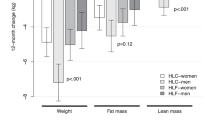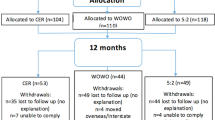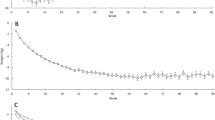Abstract
Background/Objective:
Although reducing energy density (ED) enhances weight loss, it is unclear whether all dietary strategies that reduce ED are comparable, hindering effective ED guidelines for obesity treatment. This study examined how changes in number of low-energy-dense (LED) (<4.186 kJ/1.0 kcal g–1) and high-energy-dense (HED) (>12.56 kJ/3.0 kcal g–1) foods consumed affected dietary ED and weight loss within an 18-month weight loss trial.
Methods:
This secondary analysis examined data from participants randomized to an energy-restricted lifestyle intervention or lifestyle intervention plus limited non-nutrient dense, energy-dense food variety (n=183). Number of daily LED and HED foods consumed was calculated from three, 24-h dietary recalls and anthropometrics were measured at 0, 6 and 18 months. Multivariable-adjusted generalized linear models and repeated-measures mixed linear models examined associations between 6-month changes in number of LED and HED foods and changes in ED, body mass index (BMI), and percent weight loss at 6 and 18 months.
Results:
Among mostly female (58%), White (92%) participants aged 51.9 years following an energy-restricted diet, increasing number of LED foods or decreasing number of HED foods consumed was associated with 6- and 18-month reductions in ED (β=−0.25 to −0.38 kJ g–1 (−0.06 to −0.09 kcal g–1), P<0.001). Only increasing number of LED foods consumed was associated with 6- and 18-month reductions in BMI (β=−0.16 to −0.2 kg m–2, P<0.05) and 6-month reductions in percent weight loss (β=−0.5%, P<0.05). Participants consuming ⩽2 HED foods per day and ⩾6.6 LED foods per day experienced better weight loss outcomes at 6- and 18-month than participants only consuming ⩽2 HED foods per day.
Conclusion:
Despite similar reductions in ED from reducing number of HED foods or increasing number of LED foods consumed, only increasing number of LED foods related to weight loss. This provides preliminary evidence that methods used to reduce dietary ED may differentially influence weight loss trajectories. Randomized controlled trials are needed to inform ED recommendations for weight loss.
This is a preview of subscription content, access via your institution
Access options
Subscribe to this journal
Receive 12 print issues and online access
$259.00 per year
only $21.58 per issue
Buy this article
- Purchase on Springer Link
- Instant access to full article PDF
Prices may be subject to local taxes which are calculated during checkout
Similar content being viewed by others
References
Flegal KM, Carroll MD, Kit BK, Ogden CL . Prevalence of obesity and trends in the distribution of body mass index among US adults, 1999-2010. JAMA 2012; 307: 491–497.
NCD Risk Factor Collaboration. Trends in adult body-mass index in 200 countries from 1975 to 2014: a pooled analysis of 1698 population-based measurement studies with 19.2 million participants. Lancet 2016; 387: 1377–1396.
Marczak L, O’Rourke K, Shepard D . When and why people die in the United States, 1990-2013. JAMA 2016; 315: 241.
Sacks FM, Bray GA, Carey VJ, Smith SR, Ryan DH, Anton SD et al. Comparison of weight-loss diets with different compositions of fat, protein, and carbohydrates. N Engl J Med 2009; 360: 859–873.
Barte JC, ter Bogt NC, Bogers RP, Teixiera PJ, Blissmer B, Mori TA et al. Maintenance of weight loss after lifestyle interventions for overweight and obesity, a systematic review. Obes Rev 2010; 11: 899–906.
Hartmann-Boyce J, Johns DJ, Jebb SA, Aveyard P, Behavioural Weight Management Review Group. Effect of behavioural techniques and delivery mode on effectiveness of weight management: systematic review, meta-analysis and meta-regression. Obes Rev 2014; 15: 598–609.
Loveman E, Frampton GK, Shepherd J, Picot J, Cooper K, Bryant J et al. The clinical effectiveness and cost-effectiveness of long-term weight management schemes for adults: a systematic review. Health Technol Assess 2011; 15: 1–182.
Looney SM, Raynor HA . Behavioral lifestyle intervention in the treatment of obesity. Health Serv Insights 2013; 6: 15–31.
Geiselman PJ . Control of food intake. A physiologically complex, motivated behavioral system. Endocrinol Metab Clin North Am 1996; 25: 815–829.
Stubbs J, Ferres S, Horgan G . Energy density of foods: effects on energy intake. Crit Rev Food Sci Nutr 2000; 40: 481–515.
Poppitt SD, Prentice AM . Energy density and its role in the control of food intake: evidence from metabolic and community studies. Appetite 1996; 26: 153–174.
Rolls BJ, Bell EA . Dietary approaches to the treatment of obesity. Med Clin North Am 2000; 84: 401–418.
Karl JP, Roberts SB . Energy density, energy intake, and body weight regulation in adults. Adv Nutr 2014; 5: 835–850.
Rolls BJ . The relationship between dietary energy density and energy intake. Physiol Behav 2009; 97: 609–615.
Ello-Martin JA, Roe LS, Ledikwe JH, Beach AM, Rolls BJ . Dietary energy density in the treatment of obesity: a year-long trial comparing 2 weight-loss diets. Am J Clin Nutr. 2007; 85: 1465–1477.
Lowe MR, Butryn ML, Thomas JG, Coletta M . Meal replacements, reduced energy density eating, and weight loss maintenance in primary care patients: a randomized controlled trial. Obesity 2014; 22: 94–100.
Raynor HA, Looney SM, Steeves EA, Spence M, Gorin AA . The effects of an energy density prescription on diet quality and weight loss: a pilot randomized controlled trial. J Acad Nutr Diet 2012; 112: 1397–1402.
Ledikwe JH, Rolls BJ, Smiciklas-Wright H, Mitchell DC, Ard JD, Champagne C et al. Reductions in dietary energy density are associated with weight loss in overweight and obese participants in the PREMIER trial. Am J Clin Nutr 2007; 85: 1212–1221.
Ledikwe JH, Blanck HM, Khan LK, Serdula MK, Seymour JD, Tohill BC et al. Dietary energy density determined by eight calculation methods in a nationally representative United States population. J Nutr 2005; 135: 273–278.
Levitsky DA, Iyer S, Pacanowski CR . Number of foods available at a meal determines the amount consumed. Eat Behav 2012; 13: 183–187.
Apolzan JW, Myers CA, Champagne CM, Beyl RA, Raynor HA, Anton SA et al. Frequency of consuming foods predicts changes in cravings for those foods during weight loss: the POUNDS lost study. Obesity 2017; 25: 1343–1348.
Kaiser KA, Brown AW, Bohan Brown MM, Shikany JM, Mattes RD, Allison DB . Increased fruit and vegetable intake has no discernible effect on weight loss: a systematic review and meta-analysis. Am J Clin Nutr 2014; 100: 567–576.
Mytton OT, Nnoaham K, Eyles H, Scarborough P, Ni Mhurchu C . Systematic review and meta-analysis of the effect of increased vegetable and fruit consumption on body weight and energy intake. BMC Public Health 2014; 14: 886.
Grieger JA, Johnson BJ, Wycherley TP, Golley RK . Evaluation of simulation models that estimate the effect of dietary strategies on nutritional intake: a systematic review. J Nutr 2017; 147: 908–931.
Raynor HA, Steeves EA, Hecht J, Fava JL, Wing RR . Limiting variety in non-nutrient-dense, energy-dense foods during a lifestyle intervention: a randomized controlled trial. Am J Clin Nutr 2012; 95: 1305–1314.
Stelmach-Mardas M, Rodacki T, Dobrowolska-Iwanek J, Brzozowska A, Walkowiak J, Wojtanowska-Krosniak A et al. Link between food energy density and body weight changes in obese adults. Nutrients 2016; 8: 229.
Han SF, Jiao J, Zhang W, Xu JY, Zhang W, Chun-Ling F et al. Lipolysis and thermogenesis in adipose tissues as new potential mechanisms for metabolic benefits of dietary fiber. Nutrition 2017; 33: 118–124.
Slavin JL . Dietary fiber and body weight. Nutrition 2005; 21: 411–418.
Yao M, Roberts SB . Dietary energy density and weight regulation. Nutr Rev 2001; 59: 247–258.
Ammerman AS, Hartman T, DeMarco MM . Behavioral economics and the supplemental nutrition assistance program. Am J Prev Med 2017; 52: S145–S150.
Raynor HA, Niemeier HM, Wing RR . Effect of limiting snack food variety on long-term sensory-specific satiety and monotony during obesity treatment. Eat Behav 2006; 7: 1–14.
Anderson JJ, Nieman DC . Diet quality-the Greeks had it right!. Nutrients 2016; 8: 636.
Vernarelli JA, Mitchell DC, Rolls BJ, Hartman TJ . Dietary energy density and obesity: how consumption patterns differ by body weight status. Eur J Nutr 2016. e-pub ahead of print 13 October 2016; e-pub ahead of print 13 October 2016; https://doi.org/10.1007/s00394-016-1324-8.
Hill AJ . The psychology of food craving. Proc Nutr Soc 2007; 66: 277–285.
Sainsbury A, Zhang L . Role of the hypothalamus in the neuroendocrine regulation of body weight and composition during energy deficit. Obes Rev 2012; 13: 234–257.
Drewnowski A, Henderson SA, Driscoll A, Rolls BJ . The dietary variety score: assessing diet quality in healthy young and older adults. J Am Diet Assoc 1997; 97: 266–271.
Author information
Authors and Affiliations
Corresponding author
Ethics declarations
Competing interests
The authors declare no conflict of interest.
Additional information
Supplementary Information accompanies this paper on International Journal of Obesity website
Supplementary information
Rights and permissions
About this article
Cite this article
Vadiveloo, M., Parker, H. & Raynor, H. Increasing low-energy-dense foods and decreasing high-energy-dense foods differently influence weight loss trial outcomes. Int J Obes 42, 479–486 (2018). https://doi.org/10.1038/ijo.2017.303
Received:
Revised:
Accepted:
Published:
Issue Date:
DOI: https://doi.org/10.1038/ijo.2017.303



